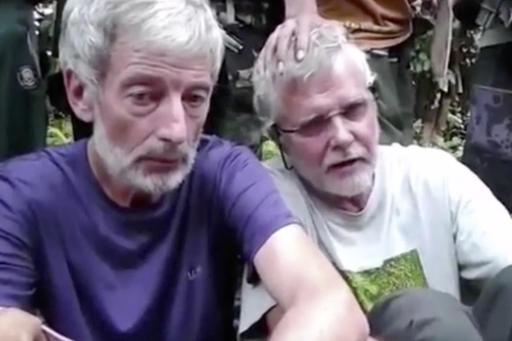
This image made from undated militant video, shows Canadians John Ridsdel, right, and Robert Hall. Militant Video via AP Video
THE military came under increased pressure on Tuesday to rescue more than 20 foreign hostages after the Abu Sayyaf bandits beheaded a Canadian man, but troops face a dilemma in how to succeed and also ensure the safety of the remaining captives.
Abu Sayyaf gunmen beheaded John Ridsdel on Monday in the southern densely forested province of Sulu, sparking condemnations and prompting Canadian Prime Minister Justin Trudeau to pledge to help the Philippines pursue the extremists behind the “heinous act.”
Ridsdel’s head, which was placed in a plastic bag, was dumped by motorcycle-riding militants Monday night in Jolo town in impoverished Sulu, about 950 kilometers (590 miles) south of Manila, where the Abu Sayyaf and allied gunmen are believed to be holding 22 foreign hostages from six countries.
It’s a politically-sensitive time to carry out major offensives at the height of campaigning in a closely-fought race by four contenders in May 9 presidential elections. President Benigno Aquino III and opposition politicians have had differences over the handling of the Mindanao conflict and the poverty and social ills that foster it.
“The pressure on the armed forces is really immense,” analyst Julkipli Wadi said. “The approach is still conventional and largely detached from the overall political question.”
Philippine National Police Director General Ricardo Marquez talks to the media after reading a joint statement from the military and police on the beheading of Canadian hostage John Ridsdel of Calgary, Alberta by Muslim extremist Abu Sayyaf Group .AP Photo/Bullit Marquez
The military and police said “there will be no letup” in the effort to combat the militants and find the hostages, even though they have had little success in safely securing their freedom. Many hostages were believed to have been released due to huge ransom payments.
“The full force of the law will be used to bring these criminals to justice,” they said in a joint statement.
About 2,000 military personnel, backed by Huey and MG520 rocket-firing helicopters and artillery, were involved in the manhunt for the militants, who were believed to be massing in Sulu’s mountainous Patikul town, military officials said.
Among the 22 hostages are 14 Indonesians who were kidnapped from tugboats in two separate incidences. Indonesian President Joko “Jokowi” Widodo said Tuesday that his country will host talks with Malaysia and the Philippines this week to boost maritime security following those hijackings.
While under pressure to produce results, government troops have been ordered to carry out assaults without endangering the remaining hostages, including in the use of airstrikes and artillery fire, a combat officer told The Associated Press by cellphone from Sulu.
He spoke on condition of anonymity because he was not authorized to talk to reporters.
In past militant videos posted online, Ridsdel and fellow Canadian Robert Hall, Norwegian Kjartan Sekkingstad and Filipino Marites Flor were shown sitting in a clearing with heavily armed militants standing behind them. In some of the videos, a militant aimed a long knife on Ridsdel’s neck as he pleaded for his life. Two black flags with Islamic State group-like markings hung in the backdrop of lush foliage.
The four were seized from a marina on southern Samal Island and taken by boat to Sulu, where Abu Sayyaf gunmen continue to hold several captives, including a Dutch bird watcher, who was kidnapped more than three years ago.
A joint statement of the military and police on the beheading of Canadian hostage John Ridsdel of Calgary, Alberta by Muslim extremist Abu Sayyaf militants. AP Photo/Bullit Marquez
In Canada, Ridsdel was remembered as a brilliant, compassionate man with a talent for friendship.
“He could bridge many communities, many people, many situations and circumstances and environments in a very gentle way,” said Gerald Thurston, a lifelong friend of the former mining executive and journalist who grew up with him in Yorkton, Saskatchewan.
Thurston said Ridsdel is survived by two adult daughters from a former marriage.
The Abu Sayyaf began a series of large-scale abductions after it emerged in the early 1990s as an offshoot of a separatist rebellion by minority Muslims in the predominantly Roman Catholic nation’s south.
It has been weakened by more than a decade of Philippine offensives but has endured largely as a result of large ransom and extortion earnings. The United States and the Philippines have both listed the group as a terrorist organization.
RELATED VIDEO